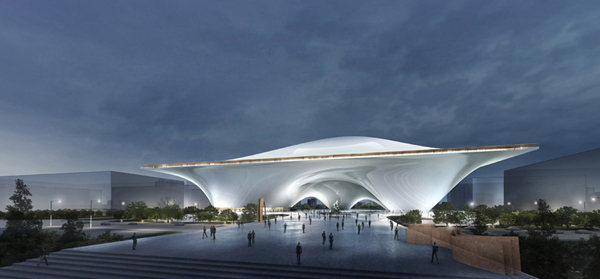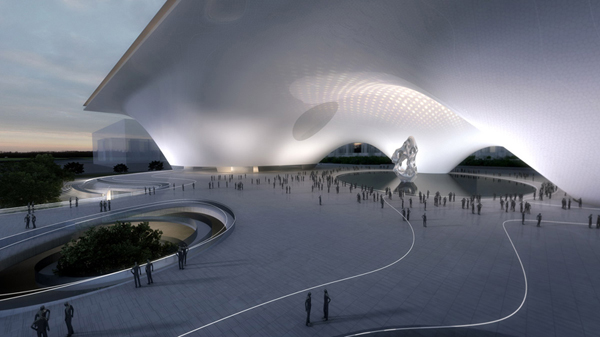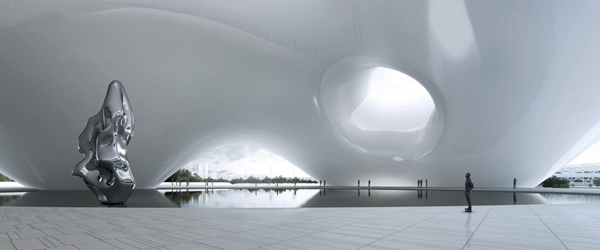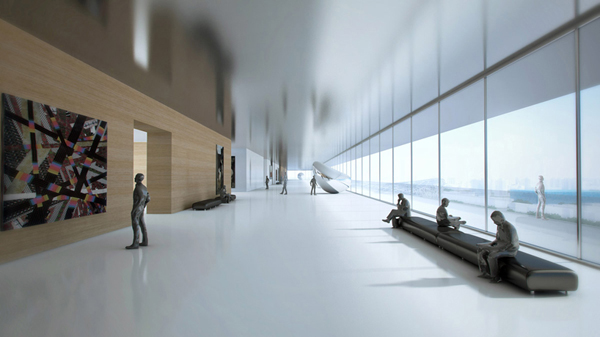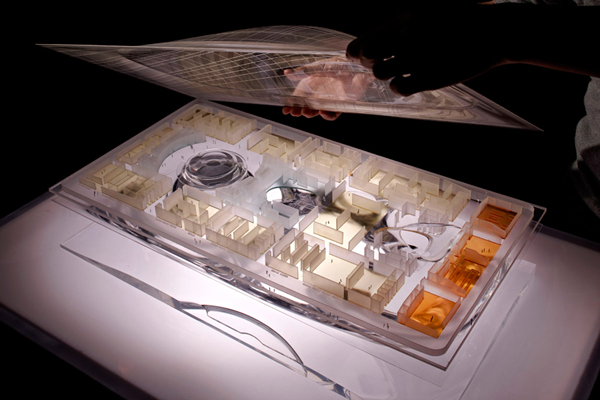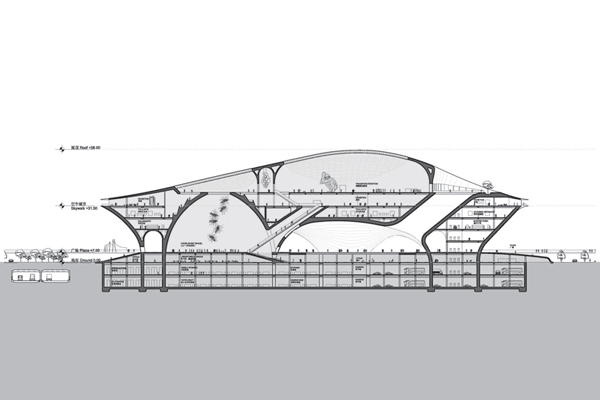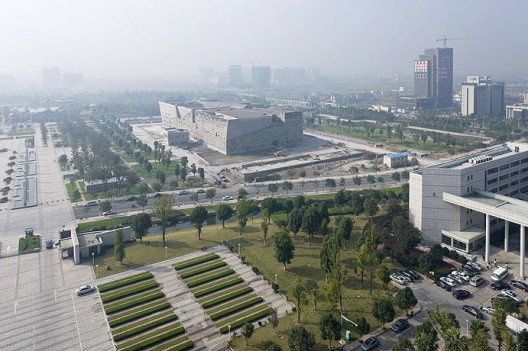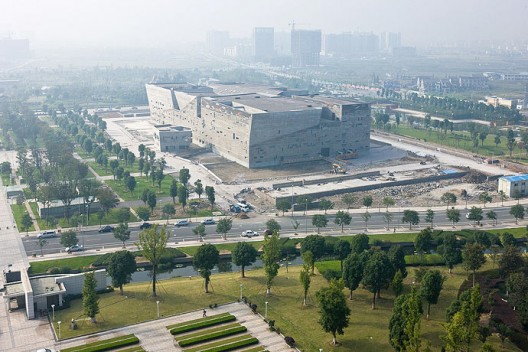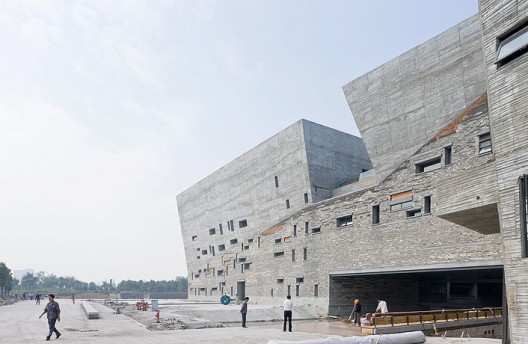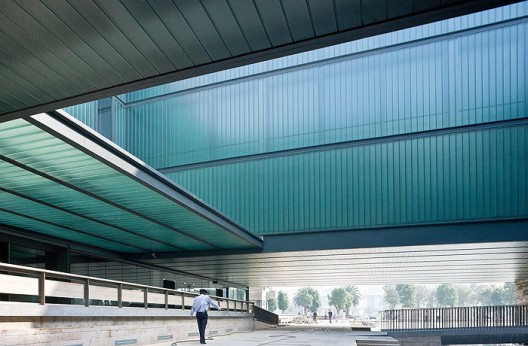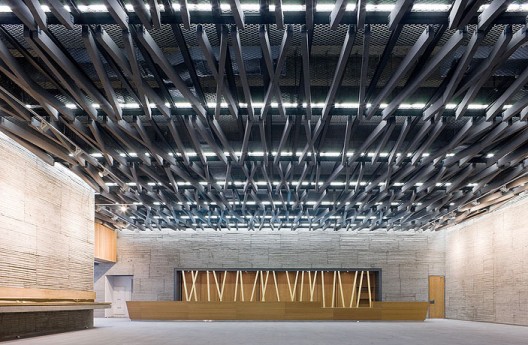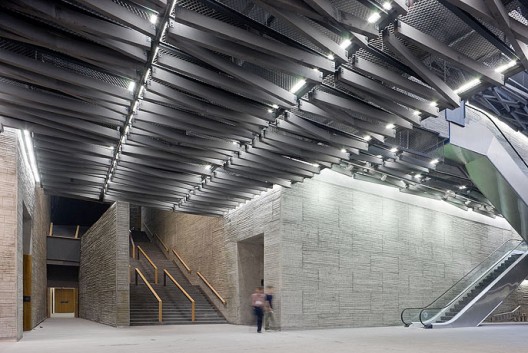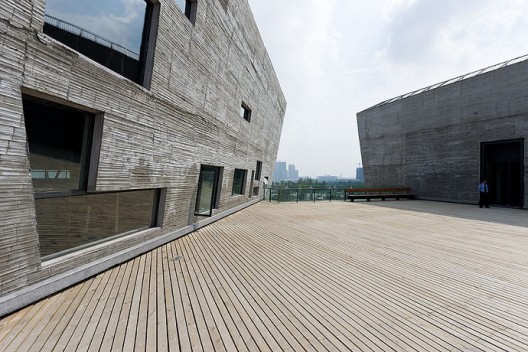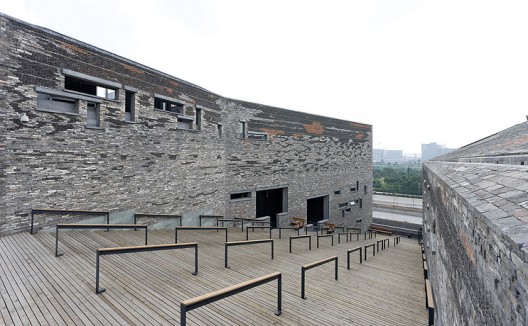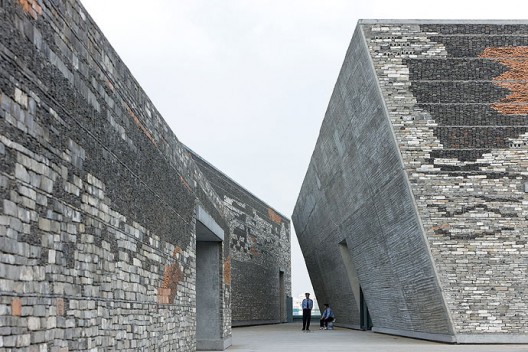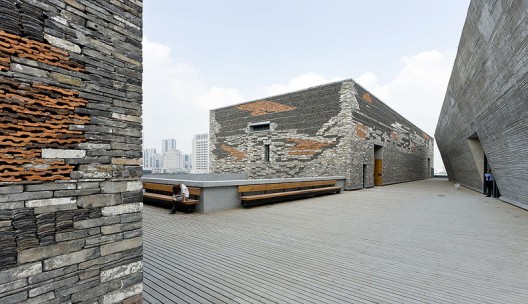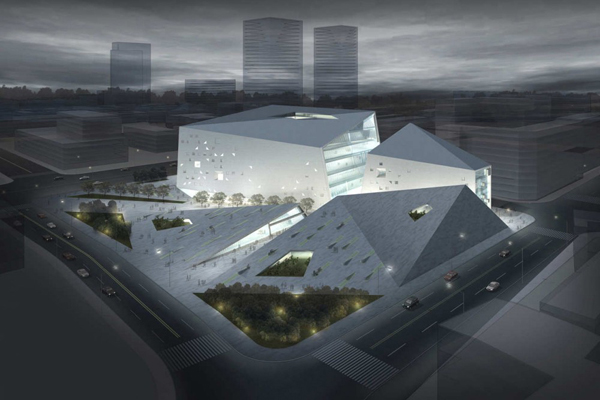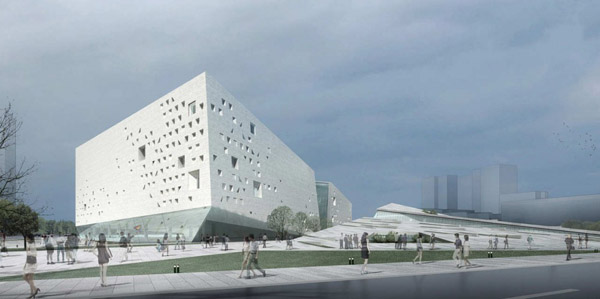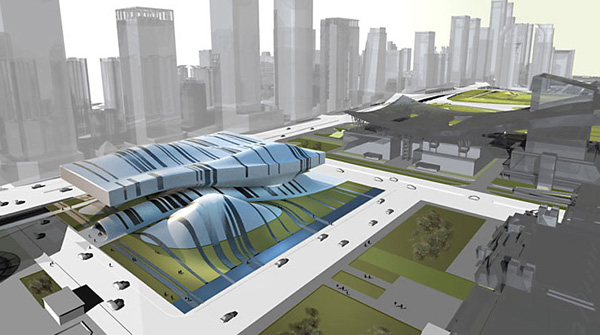This is a collection of images and articles that cover the astounding new museums of art being built or already built-in China over the last few years. The startling rise of China’s gigantic economy is being matched by their movement and presence on the global stage. China has both centers for art production in Shanghai and Beijing, and a dazzling new international art market that will also be the third reveal of the phenomenal Art Basel art fair, which debuts in Hong Kong in 2013. No where else on earth is as fast-moving as the exponential growth in the China art scene and art worlds. China already has world-class collectors and collections, and is repatriating art purchased in the West back into its country of origin. China also is positioned in the secondary markets with its own global branded auction houses. China is building remarkable and gorgeous, stunningly beautiful museums that represent everything from a region to the nation to a single person contemporary artist. Yet what will further ground all the cultural movement are these new and amazing super-large scaled museums of art. Take for example the Chinese Museum of Wood. It is both spiritual and everyday, and holds most rewarding examples of works created in the woodworking tradition. Fortunately for us in the West, and in the US in particular, we will finally get to see China showcase itself in all of its cultural manifestations – no different than has Paris, with its various historic museums both small and enormous, that are markers of civilization for all the accomplishments of humanity.
Vincent Johnson
Los Angeles
10.9.2012
CHINA DAILY RECENTLY reported that 100 new museums open in China every year. Some are private, some are linked to upmarket shopping malls, and others are public institutions established by a government that seems suddenly to be aware of the cultural deprivation it has imposed on its citizens over recent decades. Since 1949, a lot of Chinese culture simply just disappeared.
Now suddenly Chinese contemporary art has become a hot commodity with records being broken at auction almost every week and official institutions running hard to catch up with collectors who are opening their own private museums and galleries.
Nowhere is this more evident than in Shanghai a city of 25 million people and one clearly making a play to become the cultural centre of China; in the previous 12 months alone Shanghai has seen the opening of China’s largest private contemporary art museum – The Long Museum – and two monolithic public art spaces, the Power Station of Contemporary Art and the New China Art Museum in the refurbished China Pavilion on the 2010 China Expo site.
The Power Station of Contemporary Art, on the banks of the Huangpu River, was converted over a frenetic nine months from the Nanshi Power Plant into mainland China’s first state-run contemporary art museum at a cost of US$64 million. It may not be the equivalent of London’s Tate Modern, yet, but its conceptual heart is beating confidently within its 41,200-square-meter space which itself is dwarfed by the 62,000 square meters of the colossal New China Art Museum.
Museums both private and public seem to be sprouting everywhere. But it is an activity that requires big bucks; the infrastructure is staggering, the ongoing costs breathtaking and the cost of the art beyond the reach of all but the über-rich.
Chinese property developer Dai Zhikang is currently putting the finishing touches to a huge US$480 million development in Shanghai’s rapidly expanding Pudong District. The Himalayas Centre designed by acclaimed Japanese architect Arata Isozaki, includes conference facilities, luxury hotel, restaurants and shopping spaces; located on the top floor of the development is Zhikang’s soon-to-be-opened vast curvilinear Shanghai Zendai Himalayas Art Museum in which he will show his own art collection.
Across Shanghai and located in the equivalent of London’s Bond Street, is billionaire Adrien Cheng’s newly opened K11 shopping mall. Known as the ‘Art Mall’, K11 specialises in high-end Western brands. Burberry and Valentino are already in place but the mall is so new that many of the shops are vacant. It still smells of fresh paint and plastic and the highly polished floors are as yet unscuffed. The basement is a dedicated low- ceilinged art gallery that will show work by the country’s leading artists. Last month’s inaugural Shanghai Surprise exhibition was a group show with work from several local art stars including, Yang Fudong, Qui Anxiong and Birdhead.
Close by in the famous Bund area of the city is billionaire Thomas Ou’s Rockbund Art museum housed in an exquisitely restored 1933 Art Deco building that was at one time home to the Royal Asiatic Society. Ou’s large contemporary art space which opened in 2010 has no permanent collection but hosts impressive contemporary shows by leading Chinese artists.
Wang Wei, wife of billionaire entrepreneur Lui Yiqian, has recently opened (December 2012) the largest contemporary art museum in China in Shanghai’s Pudong district. The 10,000-square-meter Long Museum was built to showcase her collection of contemporary and revolutionary Chinese art with the upper floor devoted to ancient Chinese art and antiques which are her husband’s preferences. Wei plans a second museum later this year, part of the West Bank Cultural Corridor in Xuhui District, and will show even more of her collection of contemporary Chinese art.
Not to be out done Budi Tek, an Indonesian-Chinese agribusiness billionaire and Shanghai resident, will also open his Yuz Museum Shanghai on the same Xuhui site to accommodate his personal collection of international and Chinese contemporary art.
Lorenz Helbling, who owns the commercial ShangArt Gallery, has lived in Shanghai since 1995 and has witnessed the growth of private museums in the city. ‘In 1995, no one came to Shanghai to look at art. Now Shanghai is a contemporary city, a city of today and people here are interested in contemporary art even though they are still trying to understand what it art is all about,’ he said dryly.
There are a million millionaires in China but it is only the billionaires – of which there are 122 according to Forbes Magazine – who can afford the private galleries and the art to put in them. Their wealth has grown in parallel with an economy that has embraced, ‘capitalism with Chinese characteristics.’ These nouveaux riches are, a ‘fast-growing thicket of bamboo capitalism,’ as The Economist magazine labelled them, with a cashed-up status that has in effect, allowed them to corner the contemporary art market during a period when government cultural institutions seemed uninterested.
Some critics have labelled private museums as vanity projects and a flaunting of wealth. But Wei and Tek, both of whom spoke to Asian Art Newspaper last month in Shanghai, see such accusations as short-sighted. Their galleries are precisely planned philanthropic endeavours which come with clearly defined social responsibilities which include educational and lecture programmes.
Wang Wei’s Long Museum which opened last December in Pudong, cost of 271 million Yuan (US$43 million) to build and is bank-rolled by her billionaire industrialist husband, Liu Yiqian. The 10,000 square-meter space will cost 7 million Yuan annually to run Liu told CCTV recently. But the sobriquet of the Long Museum being China’s largest private museum will be short-lived. Later this year, Wang Wei will open her second even larger 16,000-square-meter, contemporary art space on an abandoned airfield that is being turned into the West Bank Cultural Corridor (WBCC) in Xuhiu District on the banks of the Huangpu River. The WBCC is being pioneered by local Party Secretary, Sun Jiwei and will comprise tourist attractions, restaurants, commercial space and parkland. DreamWorks Animation has already signed a multi-million dollar deal to build a movie studio and entertainment zone on the site.
Wang Wei’s museum will not be the only one on the site either. Tek is building his own privately financed Yuz Museum Shanghai there too. ‘Right next door to DreamWorks,’ Tek said. Tek’s 8,000-square-meter building designed by acclaimed Japanese architect, Sou Fujimoto is the first phase of a development that will eventually take in adjacent land and add a further 20,000 square meters of exhibition space. Wang Wei and her husband Liu Yiqian have been collecting Chinese art for over 20 years. Liu, who is 171 on Forbe’s Magazine China Rich List with an estimated fortune of US$790 million has a passion for ancient and antique Chinese art while Wang Wei has preferred to concentrate on Chinese contemporary and modern and in establishing a museum quality narrative collection of Revolutionary Chinese art that covers 1945 to 2009. Fifteen minutes spent inside the Long Museum is long enough to realise that no expense has been spared; from its soaring 14-meter ceiling of the Central Hall to the unpolished marble flagstones of the stair well to the fastidious nature of the displays, all speak of a high degree of finesse rarely seen in private or public galleries.
News China reported that Lui Yiqian and Wang Wei spent US$139 million on art in 2009 the same year Yiqian set an auction record for a piece of Chinese furniture when he paid US$11 million for an 18th-century Imperial Qianlong period zitan throne, which is now displayed on the third floor of the Long Museum alongside ancient scrolls and fine porcelain all of which are bathed in pools of soft light triggered by the movement of visitors through the gallery. Annual running costs of seven million Yuan have led commentators to question the sustainability of private museum. But Wang Wei dismisses concerns about sustainability and points out that the name, Long Museum, was chosen because its Chinese pictogram means long-lasting. ‘The Long Museum will last for one hundred years,’ she said.
Budi Tek, whose Shanghai Yuz Museum will be the second museum to carry this name, the first opened in Jakarta in 2008, while happy to stump up the cost of both the building and establishing the collection, remains all too aware that the museum’s long- term viability lies in making it sustainable. He, like Wang Wei, will charge a small entrance fee somewhere between 50 and 100 Yuan he says and which visitors will be able to redeem against other onsite purchases. He plans to generate income from other elements of the development. For example, there will be design and furniture stores, restaurants, book shops and residences onsite which will be available to the public when not being used by artists. But he insists everything will be art-related and all profits will be returned to the museum.
Tek believes there is now too much money chasing too few works of contemporary Chinese art leading to a dearth of affordable museum quality pieces coming on to the market. ‘In China the most important pieces of contemporary Chinese art are already held by us collectors. There are no major museum collections yet,’ he said. Which of course begs the question, what will the mega-public exhibition spaces such as the PSA put on their walls?
More recently, Tek’s collecting has turned away from Chinese contemporary to international installation artists such as Fred Sandback, Antony Gormley and Adel Abdessemed, works that require a lot of space. He is an intuitive and slightly impulsive buyer and while he is happy to defer exhibition decisions to a curator he insists the decision about what he buys is his alone. ‘No one advises me. I see something and I buy it. No one advised me when I bought Maurizio Cattelan’s olive tree. No one advised me when I bought Adel’s plane.’
For her part, Wang Wei is adamant that her collecting policy is driven by a desire to reclaim her culture. It is a philosophy she has pursued resolutely throughout her 20 years of collecting. She insists that Chinese art should remain firmly in Chinese hands and it is this philosophy that has driven her definitive collection of Revolutionary Art. And she does not share Tek’s concerns about the dearth of good contemporary art coming onto the market. For the Long Museum’s opening exhibition 15 leading Chinese contemporary artists including Zhang Xiaogang, Fang Lijun, Yue Minjun and Zeng Fanzhi created work to hang in the Central Hall. When asked if she owned the 15 works, a spokeswoman for Wang smiled and said, ‘Not yet!’.
Many commentators who question the sustainability of the private museums are also sceptical as to whether they can successfully operate in a climate where the commercial, cultural and political so closely overlap.
The shifting line between what can and cannot be shown in China was highlighted in May this year when Chinese censors excised several Andy Warhol images of Chairman Mao from a touring exhibition 15 Minutes Eternal, of 300 Warhol pictures before it reached Shanghai’s PSA. The images had already been seen in Hong Kong, but were deemed to be irreverent and unsuitable for mainland consumption. The Mao pictures will be reinstated when the exhibition moves on to Tokyo. While the Chinese government is happy to pursue its ‘soft culture’ push overseas, it remains highly sensitive to images that could offend at home.
There are few images in Wang Wei’s collection of Revolutionary Art, with its litany of happy smiling peasant faces and images that extol Chairman Mao’s achievements over half a century of communist party control that would offend the Party hierarchy. Even so Wang Wei takes a cautious ‘softly, softly’ approach and sees her collection in broad terms as, ‘complementary to national collections which for historical reasons cannot present certain art,’ she said enigmatically. Shanghai citizens however are flocking to the new cultural icons throughout the city. Helbling says that since the first Shanghai Biennale in 1996 there has been a steady and growing interest in contemporary art and that now, the big problem for Chinese public galleries is ‘trying to sort out what type of contemporary art they will have’.
BY MICHAEL YOUNG
===
http://www.evolo.us/architecture/national-art-museum-of-china-proposal-mad-architects/
National Art Museum of China Proposal / MAD Architects
The building was designed by MAD Architects, as proposal for the international competition for the future National Art Museum of China in Bejing. Their concept is based on an elevated public square which is protected by a floating mega volume above.
The original structure of the National Art Museum of China (NAMOC) built in 1962, houses one of the country’s largest art collections and has played host to some of the influential exhibitions as recorded in contemporary Chinese history. The current plans are to move the institution into a new building, situated within a designated ‘art district’ on the central axis of the 2008 Olympic site.
MAD’s design is organized into three layers, where programs are divided by each level. The one-storey ground floor houses all ancillary functions and is conceived in such a way that it can be operated independently from the museum in off hours. Above this, a 20,000 square meter urban plaza program acts as the main gallery for permanent art collections and exhibitions. The arrangement of this hall gives visitors the opportunity to decide how to engage with the works on show, while simultaneously being surrounded by outward views of the surrounding cityscape courtesy of windows that wrap around the perimeter of the structure. This level is also directly connected to the former Olympic park via a bridge, thus making use of an area of the urban plan which would otherwise be ignored.
—

This is design of a Beijing based architecture firm named MAD, they unveiled their new museum for Chinese wood sculptures. The museum is located in Habrin main city in Northern China. The city itself is currently trying to defining itself as a regional hub for the arts at a time when the historic city is rapidly expanding. That’s why they choose to build this museum right there right now. The main idea of the Chinese wood sculptures museum is inspired by the unique local landscapes of the city. The museum is a contrast between the elegance of nature and the speed of daily life. The museum is about 200 meters long and for the concept is shaped to explore and reflect the relation between the building and the environment as a big frozen fluid. The interior of the museum is separated on two general parts. Each one represents an expedition. They are connected mutually by a centralized entrance which separates the two museums while simultaneously joining them. This is used to make the impression of symbiotic relationship between the two expeditions. Another good idea by the designers is the full glass roof, this not only make the outside of the building outstanding and looking futuristic, but also helps for the sunlight to lighten the entire museum and helping for the viewing atmosphere inside.

Shanghai To Transform China Pavilion Into Art “Palace”
City Sets Ambitious Goal To Open 16 New Museums By 2015
The China Pavilion Will Reopen as the China Art Palace next fall
Shanghai may be known as a city obsessed with the pursuit of money, but in recent years China’s most populous metropolis has busied itself with another obsession: rivaling Beijing as a cultural and artistic hub. As Jing Daily noted this past May, while Beijing still enjoys its status as China’s cultural and political capital, the city’s rampant growth over the past decade has cannibalized many of its vibrant arts districts and threatened many others, alienating the creative community and, in some cases, pushing artists to relocate.
This shift in Beijing, and Shanghai’s well-capitalized initiative to foster a more creative environment in the city, has invigorated Shanghai’s cultural ambitions. Over the last few years, new creative/lifestyle venues like 1933 (a restored Jazz Age abattoir), the Shanghai Songjiang Creative Studio, and the Rockbund Art Museum have opened their doors. Though red tape and fly-by-night private gallery owners continue to plague the industry, by 2015, Shanghai plans to open 16 more large-scale museums and galleries.
As Shanghai Daily writes this week, one of these 16 planned museums and galleries, the massive “China Art Palace,” is attracting particular attention. For the art “Palace,” the China Pavilion from last year’s Shanghai World Expo is being transformed into an art museum “on a par with the Metropolitan Museum of Art in New York and the Musee d’Orsay in Paris,” according to a senior official. From the article:
The China Art Palace will collect top-level art from home and abroad, primarily to showcase the origins and development of China’s modern arts.
It is part of a plan by the city government to build 16 new major museums and art galleries and many smaller museums by 2015 and make Shanghai an “international cultural metropolis,” said Zong.
“In the future, Shanghai residents will be able to find a museum and cultural venue within a 15-minute walk of their homes,” she said.
“The number and quality of art galleries and museums is an important measure of cultural standing – cities such as New York and Paris are famed for their top-level galleries,” said Teng Junjie, art director of the Shanghai Municipal Administration of Culture Radio Film and TV.
The palace, which will cover an area of 70,000 square meters, will open on a limited basis next October, Zong said.
Most facilities from the former China Pavilion can be retained, bringing considerable savings, she said.
The three levels of the former main exhibition hall of the Expo pavilion will showcase the history and development of modern art of Shanghai and China, while the former joint pavilion for Chinese provinces and municipalities will have separate exhibition rooms for famous Chinese modern artists, including top Shanghai painter Cheng Shifa, said Teng.
As Teng Junjie added this weekend, the aim for cultural officials is to establish three major museums in the city by 2015: “the existing Shanghai Museum, the Shanghai Art Palace and the China Contemporary Art Museum – for historic, modern and contemporary artworks.” But, large scale public projects aside, more museums and galleries won’t do much to transform Shanghai into a cultural hub to rival New York, Paris or even Beijing unless, as Jing Daily pointed out earlier this month, the regulatory environment for private museums and galleries is transformed as well.
=====================
Super-Collector Wang Wei’s Dragon Art Museum Hits Construction Milestone
12,000 Square Meter Museum Located In Shanghai’s Pudong District
Zhong Song’s exterior design, featuring a projection of Chen Yifei’s 1987 painting, “The Flute Player”
This past February, Jing Daily covered Chinese art “super-collector” Wang Wei’s long-discussed private art museum in Shanghai, which Wang and billionaire investor husband Liu Yiqian plan to open next year. The “Dragon Art Museum” (龙美术馆) will showcase Wang and Liu’s extensive collection of blue-chip Chinese contemporary art on the ground floor, Wang’s Mao-era “Red Classics” from 1949-1979 on the second, and traditional works and ancient artifacts on the third floor.
Taking over a section of the former Tomson Centre (汤臣别墅商业中心) building in Shanghai’s Pudong district, near the Shanghai New International Expo Center, Wang’s museum will expand the original 8,000 square meter space to 12,000 square meters. With around 15 months to go until the museum’s planned November 18, 2012 grand opening, last weekend construction teams hit a milestone, starting work on the building’s facade.
Designed by Zhong Song (仲松), a “post-70s generation” artist and architect who started off his career at the studio of the late Beijing artist Chen Yifei, the museum’s facade is at tasteful and minimalist, going against the current preference for all things large and loud in the world of Chinese architecture. According to Zhong, the concept of the building’s facade is “clean and quality,” adding that he will use only light-colored granite for the exterior, installing fewer and smaller windows in order to give “a feeling of wholeness” to the building.
Based on an artist rendering of the exterior, which shows a projection of Chen Yifei’s 1987 work, “The Flute Player” on the museum’s facade, expect some high-tech features to be worked into the low-key granite-and-glass design. In addition to the facade currently under construction, crews will soon start work on the auxiliary warehouse, with all construction expected to be complete by the end of this year.
As Wang Wei told the Chinese art magazine Art Finance earlier this summer, she and Liu Yiqian have already invested over 200 million yuan (US$31 million) in the project, and are projecting an annual operating budget of 5 million yuan (US$774,000).
==================
http://imgace.com/pic/2012/09/comic-art-museum-in-china/
MVRDV: china comic and animation museum

‘china comic and animation museum’ by MVRDV, hangzhou, china
images © MVRDV
dutch practice MVRDV has won the international competition for the ‘china comic and animation museum’
in hangzhou, china. composed of eight balloon shaped volumes, the design looks to create an internally complex
experience measuring 30,000 square meters in total. fantastical and whimsical in its approach, the proposal is
part of a larger master plan that will include a series of parks, a public plaza and an expo center.

comic book library with view into interactive exhibition zone
set to break ground in 2012, the museum seeks to create a platform which will unite the evolving worlds of art
and entertainment. the application of one of the most iconic cartoon motifs – the speech bubble – allows the unit
to be instantly recognized as a place for comics, animation and cartoons. as text is projected onto the
monochromatic exterior surface, the forms come to life, further transforming the two dimensional motif into a
three dimensional reality.

interactive exhibition space
each of the eight volumes, occupied by unique and independent functions, are interconnected allowing for a
circular tour of the entire building. large voids at the point of interception provide visual connection and access
between the dynamic programs, which include a comic book library and three cinemas.

exhibition space
accommodating a range of versatile exhibition spaces, the museum will feature a permanent collection that is
presented in a chronological spiral along with smaller, adaptive halls for temporary displays.

exhibition space

entrance and view into multiple balloons

interactive light elements

aerial view of site

diagram of programs
additional images of the circulation zones:


==
http://www.designboom.com/weblog/cat/9/view/20727/foster-partners-datong-art-museum.html
foster + partners: datong art museum
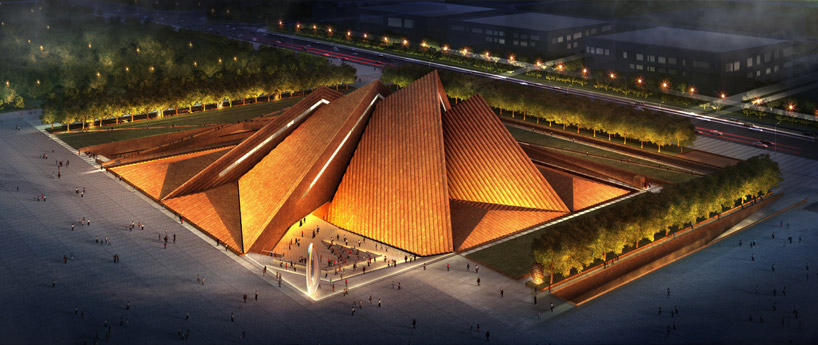
‘datong art museum’ by foster + partners, datong, china
all images © foster + partners
construction has begun in datong, china on the ‘datong art museum’, designed by london-based practice foster + partners.
four pyramidal roof peaks interlock to define the exterior form, evoking the imagery of an erupted landscape. the external surfaces
are clad with corten steel, a material with earthen hues and will continue to weather over time. one of four new buildings bordering
a new cultural plaza, the 32,000 square meter center will be slightly sunken into the earth, matching the scale of its neighbors.
visitors descend through a stepped courtyard of sculptures to enter the museum.
at the ground level, a grand gallery with a 37 meter tall atrium with a clear span of 80 meters provides a centerpiece area
for large-scale installations and exhibitions. skylights within the high ceilings introduce northern and north-western daylight,
creating an optimal environment to display artworks with natural illumination and minimal solar gain.
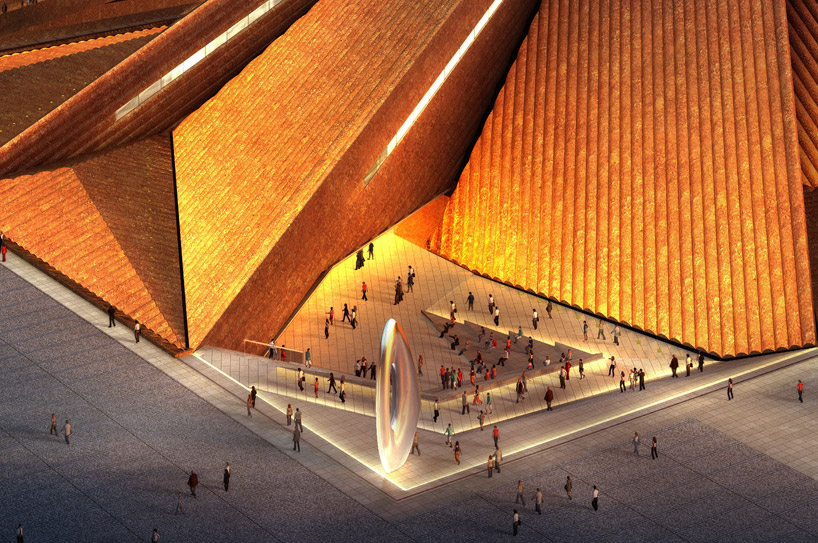
aerial view of the entry plaza at night
perimeter exhibition spaces will contain state-of-the-art climate controls. artificial lighting runs along tracks within ceiling recesses
and a 5 meter grid along the floor integrates security, data and power. with 70 percent of the structure formed from a roof,
the building is insulated almost twice more than code requires, reducing the presence and necessary maintenance with only
10 percent overall glazing.
scheduled to open in 2013, the venue will represent the country in the ‘beyond the building’ basel art international tour.
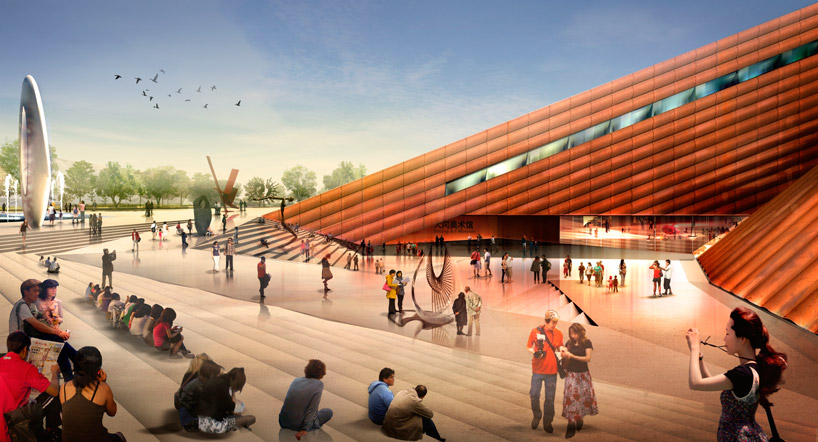
main entrance
==================
http://www.design42day.com/2011/11/the-national-art-museum-of-china-by-unstudio/
The National Art Museum of China by UnStudio
The architectural design concept for The National Art Museum of China by UnStudio reminds the artifact of ancient Chinese “stone drums”. Historically, the Stone Drum bears inscriptions that represent precious piece of the fragmentary puzzle of the Chinese script. This special form of the museum highlights the identity of the country, its spirit and essence. Moreover, the design concept is based on the duplicities that complement each other: day and night, inside and outside, fast and slow, dao or tao, individual and collective.
The main aim of this design concept is to give diversified and visible spaces for pieces of art. Also, the role of light is extremely important in the design of this building. The edifice is constructed in such a way that gives more opportunities for artists and curators in displaying their works and showing their ideas. Designers of the museum creating their work did not forget about the visitors. So, internally it is organized in such a manner that gives visitor a possibility to explore the museum by different paths around thematic consistencies of art.
Museum is greatly involved in urban context and provides the strong cultural presence for the area.
Tania Sinitsa
16/11/2011
=====================================================
http://www.iguzzini.com/Museum_Lighting_National_Museum_Of_China
The conversion and extension of the Chinese National Museum combines the former Chinese History Museum with the Chinese Revolutionary Museum. Outline plans were invited from ten international architectural firms and the project was awarded to Gerkan, Marg & Partners (gmp) for its submission, together with Beijing’s CABR, ahead of Foster & Partners, Kohn Pedersen Fox, OMA & Herzog & de Meuron.
The original GMP submission envisaged gutting the existing museum. The aim was to join the northern and southern wings in a single complex, by removing the central structure. The 260 metre long hall acts as its central access area. It widens to embrace the existing central entrance which opens onto Tiananmen Square. The ‘forum’ thus created acts as an atrium and multi-functional events area, with all services for the public, that is to say, cafes and tea shops, book shops and souvenir stores, ticket offices and toilets.
The museum lighting for the coffered roof extending along the entire forum and in the central Hall was designed by the lighting design office conceptlicht. A key feature of the concept is a special luminaire, developed by conceptlicht and produced by iGuzzini, which creates a welcoming atmosphere throughout the building.
This project required a customized solution to conceal the lighting source into the coffers. The project utilized down light optics with both traditional and LED sources.
==
http://architecturelab.net/2008/08/art-museum-of-yue-minjun/
Art Museum of Yue Minjun
from Architectural Record
Studio Pei-Zhu, a Beijing-based firm, has designed a museum that will house the work of Yue Minjun, a Chinese contemporary artist known for his repetitive images of large, smiling figures.
—————————————————————————————-
“While the devastating Sichuan earthquake in May left a large portion of Western China in ruins, signs are emerging that some notable building projects in the area are pushing forward. One of these projects is the Art Museum of Yue Minjun, designed by Beijing-based Studio Pei-Zhu, a 2007 Design Vanguard winner.
Located near the Qingcheng Mountains, and adjacent to the Shimeng River in Sichuan Province, the 10,700-square-foot museum will house the work of Yue Minjun, a Chinese contemporary artist known for his repetitive images of large, smiling figures. It will be one of 10 new museums on the same site, each dedicated to the work of an influential Chinese artist. Zhang Xiaogang and Wang Guangyi are among the other artists to be showcased. The complex, which is being developed by the local government of Dujingyuan, is the brainchild of Lu Peng, an art professor at the China Central Academy of Fine Art.


Images courtesy Studio Pei-Zhu
The Yue Minjun museum will contain exhibition space and a small artist’s studio. According to Pei Zhu, one of the firm’s principals, a river rock that he picked up one day inspired the building’s form—a large, oblong sphere. “Everything is based on the natural stone, which has a very strong relationship between the creek and the mountain and nature,” explains Zhu.
On the exterior, curvilinear walls will be clad in highly polished zinc, a soft metal that blends in with the natural surroundings while also giving the building a futuristic look. “Normally, architects will use a local material and vernacular language,” says Zhu. “We believe we needed to make something both futuristic and very natural.” It’s a striking departure from another recent project designed by the firm for the 2008 Summer Olympics: Digital Beijing, a control center whose façade resembles computer circuitry.
Work is already underway on the art museum. Site preparation began earlier this year, and the building should be completed by early 2009. Zhu says the earthquake delayed the project a mere three months, at most. “The developer still really wants to push this project [forward],” he says, “and we think that this will still benefit the society and the city.”


Images courtesy Studio Pei-Zhu
—-
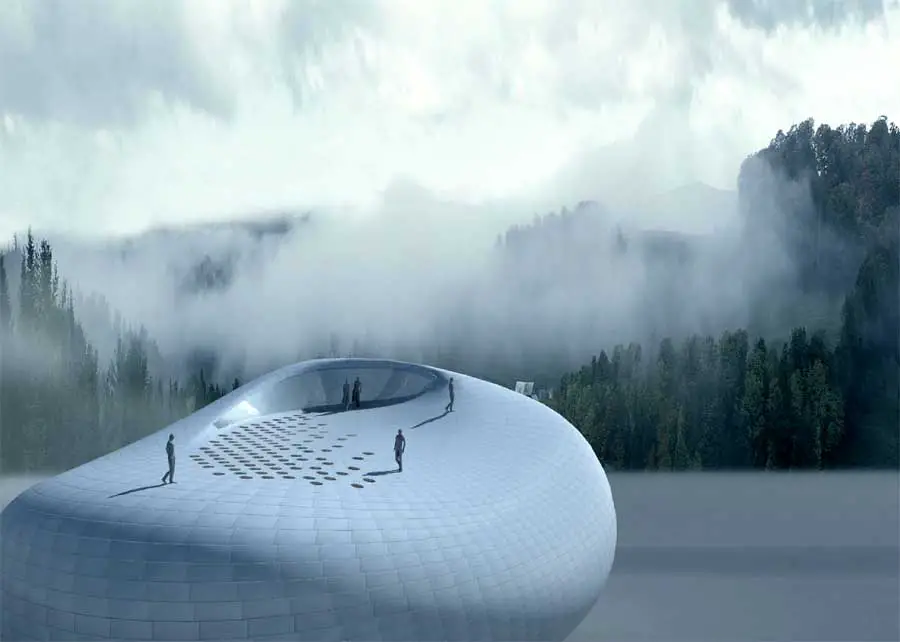
————————————————————————========================================
http://www.infoteli.com/beijing-art-museum-by-arata-isozaki-associates.htm
CAFA Art Museum
CAFA Art Museum, located at the northeast corner of campus CAFA (China Central Academy of Fine Arts), is set from curvilinear walls covered with traditional Chinese slate.
The walls are separated at the ends to which natural light enters the building through skylights and large windows.
From the main entrance, located in the center of the building, access to a large atrium in height with long straight ramps that ascend gradually to the various floors of the museum. Natural light spreads throughout the museum through the membranes of fiberglass skylights.
The ground floor can accommodate large installations that can be seen from the different levels of the ramp. The permanent collection, focusing on traditional Chinese art, is located on the first floor galleries, temporary exhibitions in the second and third floors.
Large open spaces with natural light, curvilinear walls, allow many different kinds of contemporary art installations. The exhibition space on the third floor is open to the double volume of the second floor.
There are four floors above ground, two below ground. The library and cafeteria are located in the main space on the ground floor. Basement 1 includes a reading room, a study room and a conference room. 2 In the basement offices are located in conservation of paintings and calligraphy, including the restoration room, laboratory and warehouse of temporary and permanent collections. Technical equipment protected stairways and elevators are located in rectangular volumes, covered with marble.
==
Ningbo Historic Museum / Wang Shu, Amateur Architecture Studio
- 22 Feb 2009
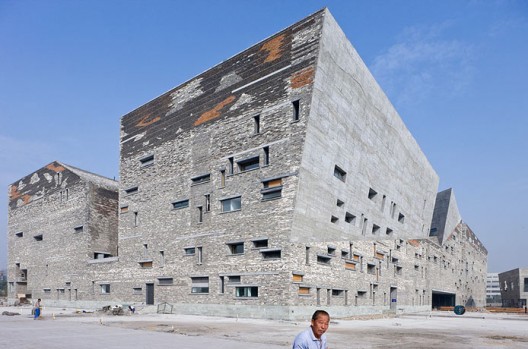
In Iwan Baan‘s website, we found one of the latest works he photographed, the Ningbo Historic Museum designed by Wang Shu, Amateur Architecture Studio.
An amazing stone work, more pictures after the break:
![Ningbo Historic Museum / Wang Shu, Amateur Architecture Studio (13) Ningbo Historic Museum / Wang Shu, Amateur Architecture Studio (13) © Iwan Baan]()
- © Iwan Baan
-
MoMA Chengdu / Studio Ramoprimo
By: Lidija Grozdanic | February – 22 – 2012Organized by the Chengdu Ministry of Culture and the Chengdu Culture and Tourism Development Group, the Competition for the Chinese MoMA was part of an initiative for creating a double ring of public facilities around the Tianfu Square in Chengdu. The first ring is supposed to consist of cultural facilities. The second and larger one is planned for highrises.
![Museum of Modern Art china Museum of Modern Art china]()
Designed by Studio Ramoprimo, the winning entry proposes a dialogue with the surrounding, drawing physical references from the existing urban and architectural condition. The basic idea is to enlarge the existing public space of Tianfu Square and make it “climbing” on the roof of the new building. The new museum is a group of volumes creating a small cultural city.
Two main axis cut the site area defining a comfortable pedestrian island where people can walk away from cars. The new urban situation is also establishing new visual and physical connections between existing parts of the city. People can pass through the plot and easily come from the Tianfu square and reach the surrounding museums. The four museum blocks create an arising slope on which people can walk, seat, play, have a rest, enjoy the view to the central square like in a open public theater. The whole shape according the function is rising step by step from the earth to the sky, while the ending corner of the building replaces the original position of the ancient and forgotten city wall.
Shenzhen Museum of Contemporary Art / LABORATORIO 543
By: Lidija Grozdanic | July – 8 – 2012The Museum Of Contemporary Art & Planning Exhibition proposal is located at Futian District, Shenzhen’s most important central region for administration, business and culture. The building functions as part of Shenzhen’s civic centre, where the City Library, Opera House, Central Bookstore, Youth Activity Hall (YAH) and other civic building have been built. The international competition held in 2007 required The Museum Of Contemporary Art & Planning Exhibition (MOCAPE) to include two independent and yet inter-connected parts: The museum of Contemporary Art (MOCA) and Planning Exhibition (PE). Designed by Rome-based LABORATORIO 543, the proposal is a 90.000 square meter structure that aims to enhance the service of Shenzhen’s new civic center.
The building is divided into two parts: the first rests on the ground and the other is suspended on the upper level. These undulating segments have multiple connection points, ensuring the overall stability of the structure and facilitating communication between different programs. The structural frame, which is required to support the suspended level, can be compared to a cantilever. Located at ground level, the main entrance belongs to a composition of
Art Museum of Yue Minjun
Share40diggposted in Newsfrom Architectural Record
Studio Pei-Zhu, a Beijing-based firm, has designed a museum that will house the work of Yue Minjun, a Chinese contemporary artist known for his repetitive images of large, smiling figures.
—————————————————————————————-“While the devastating Sichuan earthquake in May left a large portion of Western China in ruins, signs are emerging that some notable building projects in the area are pushing forward. One of these projects is the Art Museum of Yue Minjun, designed by Beijing-based Studio Pei-Zhu, a 2007 Design Vanguard winner.
Located near the Qingcheng Mountains, and adjacent to the Shimeng River in Sichuan Province, the 10,700-square-foot museum will house the work of Yue Minjun, a Chinese contemporary artist known for his repetitive images of large, smiling figures. It will be one of 10 new museums on the same site, each dedicated to the work of an influential Chinese artist. Zhang Xiaogang and Wang Guangyi are among the other artists to be showcased. The complex, which is being developed by the local government of Dujingyuan, is the brainchild of Lu Peng, an art professor at the China Central Academy of Fine Art.
![Art Museum of Yue Minjun photo Art Museum of Yue Minjun]()
![Art Museum of Yue Minjun photo Art Museum of Yue Minjun]()
Images courtesy Studio Pei-ZhuThe Yue Minjun museum will contain exhibition space and a small artist’s studio. According to Pei Zhu, one of the firm’s principals, a river rock that he picked up one day inspired the building’s form—a large, oblong sphere. “Everything is based on the natural stone, which has a very strong relationship between the creek and the mountain and nature,” explains Zhu.
Beijing To Build “World’s Largest Art Museum”: What’ll They Fill It With?This week, as part of its 12th five-year plan, Beijing announced a new phase for the National Art Museum of China, a massive, glass-covered structure that is being touted as “the world’s largest art gallery.” Currently in the design process, the new National Art Museum will be located next to the current museum and near the Beijing National Stadium, with construction expected to begin next spring.Chinese Contemporary Art Getting Scarcer; Can Auctions Be Museums’ Only Source For Top Art?
Preliminary design for the National Art Museum of China new phase
This week, as part of its 12th five-year plan, Beijing announced a new phase for the National Art Museum of China, a massive, glass-covered structure that is being touted as “the world’s largest art gallery.” Currently in the design process, the new National Art Museum will be located next to the current museum and near the Beijing National Stadium, with construction expected to begin next spring. While the new National Art Museum sounds like another example of the Chinese government building a mammoth public venue for the sake of getting another “world’s largest” title under its belt, as museum director Fan Di’an told delegates at the recent National People’s Congress, China’s public art facilities haven’t lived up to the promise of the country’s burgeoning interest in the arts.
As Fan pointed out last week, the current National Art Museum — which was built in 1963 in Beijing’s Dongcheng district — is a meager 8,300 square meters in size. Compare that to New York’s Museum of Modern Art, at 58,529 square meters, and the Louvre, which boasts over 60,000 square meters of exhibition space. Since attendance became free at the National Art Museum on March 2, according to Fan Di’an, it has clocked nearly 6,000 visitors at peak times, “nearly hitting capacity,” according to Xinhua. Clearly, the current digs are inadequate, certainly for a city that most consider to be the cultural heart of China. But how will director Fan Di’an fill the 130,000 total square meters of exhibition space he’ll have when the new phase is complete?
One clue comes from an interview Fan Di’an recently gave at the “Art Power” awards in Beijing, where he was named “Best Museum Administrator.” Speaking to Sina, Fan said that the Chinese contemporary art world is becoming stronger as more artists become globally recognized, more curators have the ability to promote Chinese art, and more (and better) museums are built across the country. Fan’s interest in contemporary art and the priority he places on public arts education have made him something of a star in the Chinese art world, a break from the stereotype of the stodgy apparatchik or stuffy administrator. Fan also counts many first-generation Chinese contemporary artists as close friends, such as his former Central Academy of Fine Arts classmate Xu Bing. With the ample room he will be afforded with the new National Art Museum, expect to see Fan display an impressive array of contemporary Chinese works alongside his other interests, which include everything from 1950s Chinese prints to artifacts from Dunhuang in Xinjiang province.
With so much room to fill, not just in Beijing but in new provincial art museums throughout mainland China, it won’t be surprising if we see museum and gallery representatives showing up at the upcoming Sotheby’s spring auctions in Hong Kong, where works by some of China’s top artists will be on the block. Directors like Fan Di’an would almost certainly love to get some pieces from the Ullens collection on the walls and prevent them from leaving the country once and for all. Now that new Chinese private collectors are getting more involved with the auction market and works by blue-chip Chinese artists are getting scarcer and scarcer, it’s no surprise that excitement is growing in China for the upcoming spring auction season.
- ——————–
-
New Abstract Paintings: The Cosmos suite (2012)
![IMG_4912]()
Cosmos. Oil on canvas 2012 by Vincent Johnson
![Cosmos Red Yellow Green]()
Cosmos Red Yellow Green. Oil on canvas 2012 by Vincent Johnson
![Green God]()
Green God. Oil on canvas 2012 by Vincent Johnson
This new painting series is part of my ongoing exploration of painting materials and techniques from the history of painting. The works combine knowledge of painting practices of both abstract and representation paintings. The works concern themselves purely with the visual power that paintings can do through the manipulation of paint. Some of the underpaintings are allowed to dry for months; some of those are built dark to light, others light to dark. None are made in a single setting. Most are worked and reworked using studio materials. Each new series takes a different approach to the painted surface from how the paint is applied, to varying the painting mediums. This suite concerns itself with the layering of paint by building up the surface and altering and reworking the wet paint with studio tools.
Two larger paintings will be completed and photographed on Sunday, July 15, 2012 and posted here.
Vincent Johnson is an artist and writer in Los Angeles
![VJ2]()
- Vincent Johnson’s Nine Grayscale Paintings – installation shot – 2
![Siver hands - 2]()
- Vincent Johnson’s Nine Grayscale Paintings – studio shot – 1 (Silver hand)
![grayscale - studio 5 - the artist vincent johnson]()
- Vincent Johnson – in my studio working on my Nine Grayscale Paintings
![Iphone photos - complete set 1637]()
- Vincent Johnson’s Nine Grayscale Paintings – first stage of grayscale painting
-
Los Angeles based artist and writer Vincent JohnsonVincent Johnson received his MFA from Art Center College of Design in Pasadena, California 1997 and his BFA from the School of the Art Institute of Chicago in Painting 1986. He started out as a student in Pratt’s painting department. He is a 2005 Creative Capital Grantee, and was nominated for the Baum: An Emerging American Photographer’s Award in 2004 and for the New Museum of Contemporary Arts Aldrich Art Award in 2007 and for the Art Matters grant in 2008, and in 2009 nominated for Foundation for Contemporary Art Fellowship, Los Angeles. In 2010 he was named a United States Artists project artist. His work has been reviewed in ArtForum, The New York Times and the Los Angeles Times, Art in America, Art Slant and many other publications. His photographic works were most recently shown in the inaugural Pulse Fair Los Angeles. His most recent paintings were shown at the Beacon Arts Center in Los Angeles.












